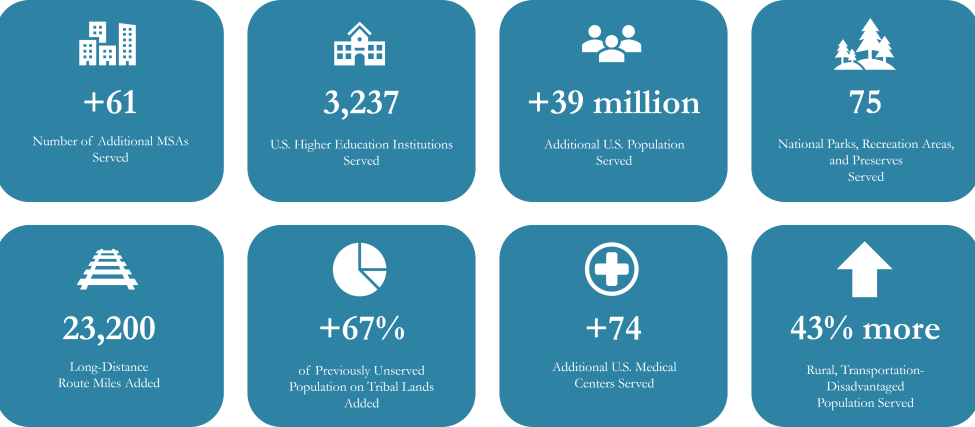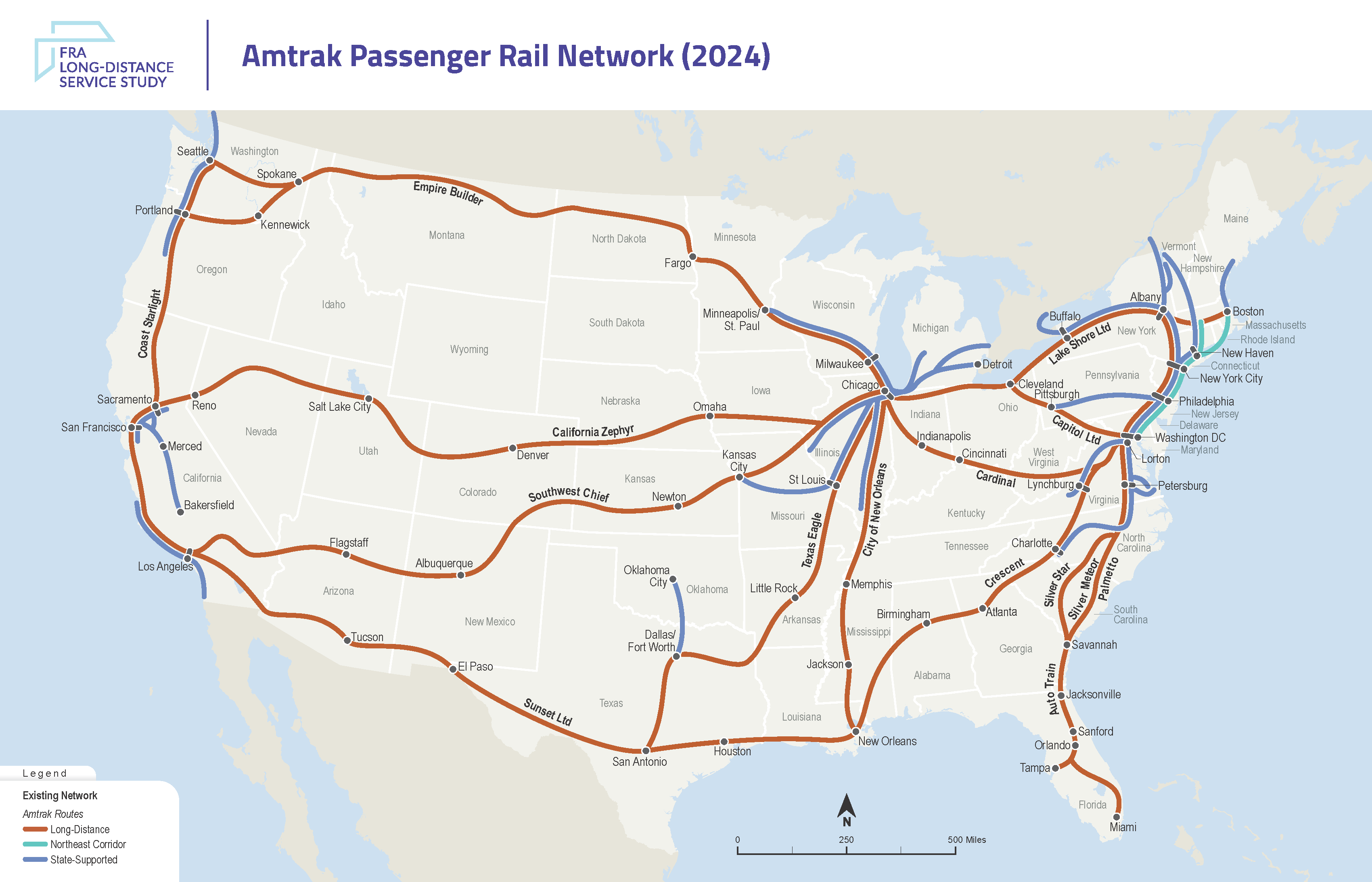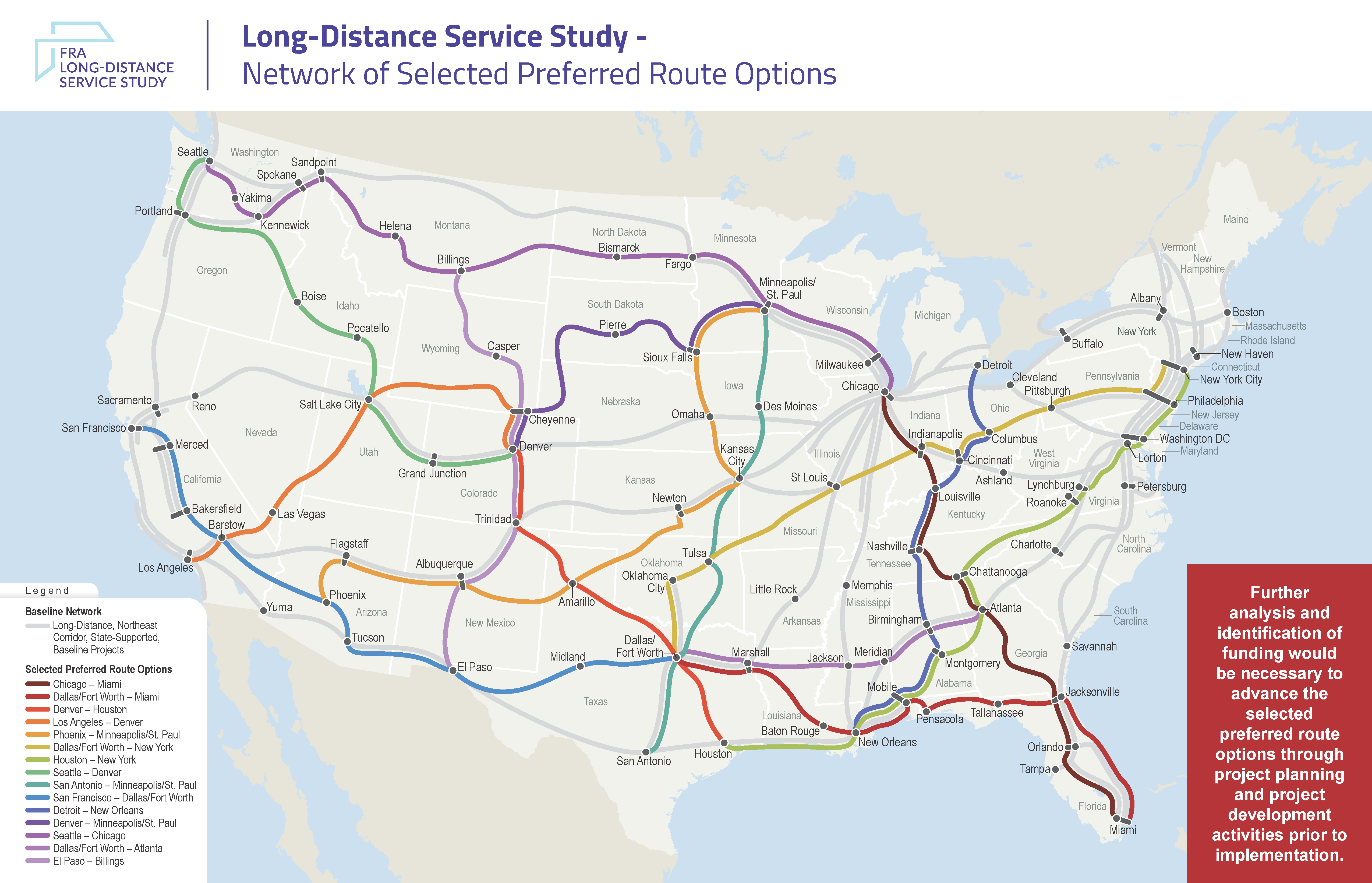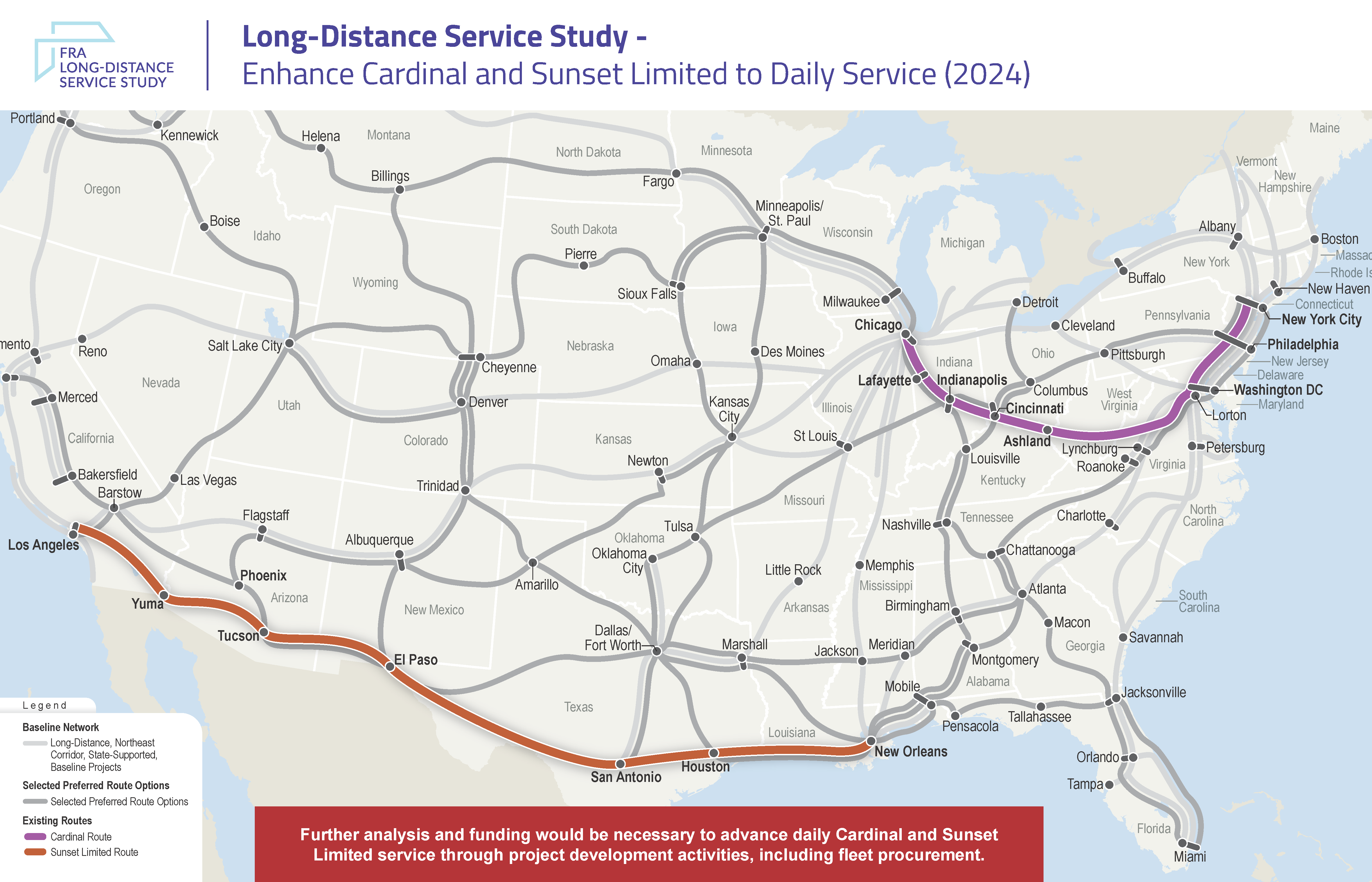Media
For media inquiries please contact FRA Public Affairs at FRAPA@dot.gov.
Summary
Amtrak Long-Distance Routes
Amtrak operates 15 long-distance passenger rail routes, which are defined in statute as Amtrak routes over 750 miles. Long-distance routes provide service at nearly half of the train stations in the Amtrak system. These routes typically operate once per day in each direction, linking and serving large and small communities across the country – although two long-distance routes (the Cardinal and Sunset Limited) only operate three times per week. Due to the length of these routes, some stations are only served at night. Long-distance routes, despite relatively low service frequencies, form an essential backbone of the national passenger rail network across 39 states and the District of Columbia, connecting passengers to shorter state-supported Amtrak routes, Amtrak Northeast Corridor routes, Amtrak Thruway bus services, and other local and regional transportation options. In fiscal year 2024, long-distance trains carried more than 4.2 million passengers.
Long-Distance Service Study
Section 22214 of the Infrastructure Investment and Jobs Act of 2021 (IIJA) directed the Federal Railroad Administration (FRA) to conduct an Amtrak Daily Long-Distance Service Study to evaluate the restoration of daily intercity rail passenger service along (1) any Amtrak long-distance routes that, as of the date of enactment of IIJA, were discontinued, and (2) any Amtrak long-distance routes that, as of the date of enactment of IIJA, occur on a non-daily basis.
The legislation stated that the FRA may also evaluate potential new Amtrak long-distance routes, with specific attention provided to routes in service as of April 1971 but not continued by Amtrak. For potential new routes, IIJA directed FRA to consider whether new Amtrak long-distance routes would:
- link and serve large and small communities as part of a regional rail network,
- advance the economic and social well-being of rural areas of the United States,
- provide enhanced connectivity to the national long-distance passenger rail system,
- and reflect public engagement and local and regional support for restored passenger rail service.
FRA used these considerations to guide the Study’s analyses and select preferred route options for long-distance service restoration, enhancement, and expansion.
FRA worked on the Study from 2022 to 2024, completing the required analyses for the Study and conducting 24 regional working group meetings with stakeholders in 21 cities across the country. The Study received over 50,000 stakeholder and public comments that indicated overwhelming support for long-distance services or passenger rail in general.
Based on IIJA requirements, the Study focused solely new or restored Amtrak long-distance services and daily service on the two Amtrak long-distance routes that currently operate with less than daily frequencies (Cardinal and Sunset Limited). It does not include recommendations for restoration or enhancement of state-supported service, the Northeast Corridor (NEC), high-speed rail, or other types of passenger rail service. Beyond the required analyses of the Cardinal and Sunset Limited, this study does not consider service changes to existing Amtrak long-distance routes. The Study is separate from other FRA programs, such as the Corridor Identification and Development Program. More information about the Corridor ID Program is available in the “Next Steps” section below.
Study Results
The Long-Distance Study Final Report creates a foundation for further planning of potential future long-distance services by developing or identifying:
- Selected preferred route options for service restoration, enhancement, or expansion.
- A prioritized inventory of certain capital project types.
- Estimated costs and public benefits.
- Recommendations for methods by which Amtrak could work with local communities and organizations to develop activities and programs to continuously improve public use of intercity passenger rail service along each route.
- Potential federal and non-federal funding sources.
The selected preferred route options reflect current travel demand, as well as opportunities to: increase passenger rail access to rural areas and transportation-disadvantaged communities; increase connectivity with existing and future passenger rail services; consider the impacts of previously discontinued long-distance passenger rail service; and address significant stakeholder input. The Final Report includes preferred options for daily passenger rail service on the Cardinal and Sunset Limited routes, as directed by IIJA.
The network of selected preferred route options, if implemented, could provide passenger rail access to 39 million people that don’t currently have access to passenger rail, including 7 million people in rural communities. The network of selected preferred route options, which could serve 34 states, could also increase access to key destinations.
FRA received comments from people across the country who would use these route options to visit family, connect to higher education and job opportunities, get medical treatment, see national parks, and travel to and from military bases and installations. Travelers with disabilities, travelers who are unable to drive, and travelers who are concerned about affordability also submitted comments supporting the network of selected preferred route options.
Potential Benefits of the Network of Selected Preferred Route Options

The Final Report also recommends consideration of a new long-distance committee made up of key stakeholders from across the country (including host railroads, states and communities served by Amtrak long-distance routes, Amtrak, and FRA) that could serve as a forum for feedback and discussion related to current Amtrak long-distance service.
Next Steps
This Study is a crucial early step in a comprehensive process to identify the actions that may be needed to enhance long-distance service, and reflects FRA’s diligent work to meet Congressional requirements, as well as significant stakeholder input. The selected preferred route options identified in this Study are conceptual – they are not final recommendations for service, and would require additional review, resources, and stakeholder collaboration after this study is complete to refine projects, costs, funding sources, and other key items needed for implementation. These additional analyses may identify different alignments and variations of the selected preferred route options.
The Final Report recognizes the significant challenges in implementing the selected preferred route options, including – but not limited to – funding and governance of Amtrak long-distance service. Currently, there is no sustained financial support or program to construct or operate the selected preferred route options identified in the Final Report, although some of them may be eligible for additional planning funds through FRA’s Corridor Identification and Development Program.
IIJA required the establishment of a new intercity passenger rail corridor planning program to help guide intercity passenger rail development throughout the country, referred to as the Corridor ID Program (49 U.S.C. 25101(a)). As part of the program, FRA works with corridor sponsors to prepare a service development plan for each selected corridor and advance capital projects identified in those plans to ready them for final design and construction. Corridors eligible under the Corridor ID Program include new passenger rail routes of less than 750 miles; the enhancement of existing passenger rail routes under 750 miles; the restoration of service overall or portions of a passenger rail route formerly operated by Amtrak; or the increase of service frequency of a long-distance passenger rail route (49 U.S.C. 25101(h)).
In December 2023, FRA announced the selection of 69 corridors into the Corrdor ID Program. Three long-distance routes identified in this Study were selected into the Corridor ID Program in December 2023, independent of the Study: Cardinal (increasing service frequency to daily), Sunset Limited (increasing service frequency to daily), and restoration of the North Coast Hiawatha, a discontinued Amtrak route that previously operated between Chicago, Illinois, and Seattle, Washington, via southern Montana. These routes have access to funding to support project planning and potentially project development activities, although there will still be significant future funding needs to advance these routes further in the FRA project lifecycle. For more information, please visit FRA Corridor ID website at https://railroads.dot.gov/corridor-ID-program
Long-Distance Service Study Maps
FAQ
FRA conducted the Study. How is FRA different than Amtrak?
Amtrak was established by the Rail Passenger Service Act of 1970, which relieved private U.S. railroads of their passenger rail service obligation and created Amtrak to fulfill that role instead. In 1971, the US Department of Transportation (US DOT) designated 21 city pairs between which intercity passenger trains should operate, and Amtrak began service between those cities later that year. The new passenger rail system was about half the size (by route miles) of the pre-1971 U.S. passenger rail system, which had been operated by multiple railroads.
Amtrak is operated and managed as a for-profit corporation – it is not a department or agency of the United States government. However, Amtrak’s mission and goals are detailed in United States Code, and Amtrak receives funds to operate and manage its services from a variety of sources, including passenger ticket revenue, cost-sharing agreements with state partners, and the federal government. Amtrak provides intercity passenger rail service to more than 500 stations in 46 states.
The Federal Railroad Administration (FRA), created in 1966, is an agency within the U.S. Department of Transportation. FRA’s mission is to enable the safe, reliable, and efficient movement of people and goods for a strong America, now and in the future. FRA accomplishes this mission primarily through: issuance, implementation, and enforcement of safety regulations; managing Federal investments in freight and passenger rail across the country, and research and technology development.
FRA’s Office of Railroad Development, which conducted this study, is responsible for working with stakeholders to develop cohesive goals and policies for maintaining and improving the U.S. freight and passenger rail networks, as well as for managing a portfolio of grant investments that contribute to achieving these goals. This office also oversees grant agreements with Amtrak to administer federal funds appropriated by Congress to support Amtrak’s operations, infrastructure, and equipment. FRA has previously conducted long-term vision plans for regional passenger rail service in the Southwest, Southeast, Midwest, and the Northeast Corridor.
What are Amtrak long-distance routes? How are they different from other Amtrak routes?
Amtrak operates almost all intercity passenger rail services in the continental United States, serving more than 500 destinations in 46 states, and several locations in Canada. Amtrak has three operating service lines: Northeast Corridor (NEC), state-supported, and long-distance. Each Amtrak route is part of a service line, and each service line and its associated routes have different service characteristics (and some have different funding sources); however, all routes in each service line are operated by Amtrak.
- Northeast Corridor (NEC) provides relatively high-frequency daily service between Boston, Massachusetts, and Washington, DC on the Northeast Regional and Acela routes. Amtrak owns most of the NEC main line.
- State-Supported provides service on 30 routes of not more than 750 miles through cost-sharing agreements with state partners, with some federal financial support. Routes typically operate on privately owned host railroad tracks.
- Long-Distance provides service on 15 Amtrak routes over 750 miles. Amtrak receives annual support from Congress for operating costs associated with long-distance routes. Routes typically operate on privately owned host railroad tracks.
This Study is focused solely on Amtrak as a service provider. Although Amtrak provides most intercity passenger rail service in the United States, a privately owned and operated passenger rail company (Brightline) provides service between Miami, FL and Orlando, FL, and there are several other non-Amtrak passenger rail routes being planned or constructed in Nevada and California.

Current Long-Distance Service, by the numbers:
- Amtrak currently operates 15* long-distance routes, ranging from approximately 760 to 2,500 miles. 13 long-distance routes operate one time per day in each direction. Two routes (the Cardinal and Sunset Limited) only operate three days per week.
- *As of November 2024, Amtrak has temporarily combined the Capitol Limited and portions of the Silver Star into one long-distance route called the Floridian.
- Long-distance routes form a backbone of the national passenger rail network across 39 states and the District of Columbia, connecting passengers to regional state-supported Amtrak routes, Amtrak Northeast Corridor routes, Amtrak Thruway bus services, and other local and regional transportation options.
- Long-distance routes are currently the only Amtrak passenger rail service available in 22 states.
- On average, an Amtrak long-distance route serves 29 stations and 8 states.[1]Long-distance routes have many different stations where passengers can (and do) get on and off the train, connecting large and small communities along the way.
- In FY24, long-distance routes carried more than 4.2 million passengers, and passengers on long-distance routes comprised a third of all passenger miles traveled in the Amtrak system.
- Although most long-distance routes provide accommodations for both coach and sleeper services, over 80 percent of long-distance passengers ride in coach.
What did this Study do?
Background
Amtrak was established by the Rail Passenger Service Act of 1970, which relieved private U.S. railroads of their passenger rail service obligation and created Amtrak to fulfill that role instead. In 1971, the U.S. Department of Transportation (DOT) Secretary designated 21 city pairs between which intercity passenger trains should operate, and Amtrak began service between those cities later that year. The new passenger rail system was about half the size (by route miles) of the pre-1971 U.S. passenger rail system, which had been operated by multiple railroads. Some cities permanently lost their connection to the passenger rail network in 1971.
At the request of Congress, several routes over 750 miles were added to Amtrak’s system in the 1970s, but long-distance service contracted in the following decades – especially after a 1979 US DOT report that recommended significant service reductions. Long-distance passenger rail service reductions over the past 50 years have resulted in some communities losing passenger rail transportation options, as well as the related economic and social benefits of those connections.
Section 22214 of the Infrastructure Investment and Jobs Act of 2021 (IIJA) directed the Federal Railroad Administration (FRA) to conduct an Amtrak Daily Long-Distance Service Study to evaluate the restoration of daily intercity rail passenger service along (1) any Amtrak long-distance routes that, as of the date of enactment of IIJA, were discontinued, and (2) any Amtrak long-distance routes that, as of the date of enactment of IIJA, occur on a non-daily basis.
The legislation stated that the FRA may also evaluate potential new Amtrak long-distance routes, with specific attention provided to routes in service as of April 1971 but not continued by Amtrak. For potential new routes, IIJA directed FRA to consider whether new Amtrak long-distance routes would:
- link and serve large and small communities as part of a regional rail network,
- advance the economic and social well-being of rural areas of the United States,
- provide enhanced connectivity to the national long-distance passenger rail system,
- and reflect public engagement and local and regional support for restored passenger rail service.
FRA used these considerations to guide the Study’s analyses and select preferred route options for long-distance service restoration, enhancement, and expansion.
FRA worked on the Study from 2022 to 2024, completing the required analyses for the Study and conducting 24 regional working group meetings with stakeholders in 21 cities across the country. The Study received over 50,000 stakeholder and public comments that indicated overwhelming support for long-distance services or passenger rail in general.
Based on IIJA requirements, the Study focused solely new or restored Amtrak long-distance services and daily service on the two Amtrak long-distance routes that currently operate with less than daily frequencies (Cardinal and Sunset Limited). It does not include recommendations for restoration or enhancement of state-supported service, the Northeast Corridor (NEC), high-speed rail, or other types of passenger rail service. Beyond the required analyses of the Cardinal and Sunset Limited, this study does not consider service changes to existing Amtrak long-distance routes.
Study Outputs
The FRA Amtrak Daily Long-Distance Service Study Final Report creates a foundation for further planning of potential future long-distance services by developing or identifying:
- Preferred options (routes) for service restoration or enhancement.
- A prioritized inventory of certain capital project types and other actions required to restore or enhance long-distance service.
- Estimated costs and public benefits of restoring or enhancing long-distance service.
- Recommendations for methods by which Amtrak could work with local communities and organizations to develop activities and programs to continuously improve public use of intercity passenger rail service along each route.
- Potential federal and non-federal funding sources.
The selected preferred route options reflect current travel demand, as well as opportunities to: increase passenger rail access to rural areas and transportation-disadvantaged communities; increase connectivity with existing and future passenger rail services; consider the impacts of previously discontinued long-distance passenger rail service; and address significant stakeholder input. The Final Report includes preferred options for daily passenger rail service on the Cardinal and Sunset Limited routes, as directed by IIJA.
The network of selected preferred route options, if implemented, could provide passenger rail access to 39 million people that don’t currently have access to passenger rail, including 7 million people in rural communities. The network of selected preferred route options, which could serve 34 states, could also increase access to key destinations.
FRA received comments from people across the country who would use these route options to visit family, connect to higher education and job opportunities, get medical treatment, see national parks, and travel to and from military bases and installations. Travelers with disabilities, travelers who are unable to drive, and travelers who are concerned about affordability also submitted comments supporting the network of selected preferred route options.
The Final Report also recommends consideration of a new long-distance committee made up of key stakeholders from across the country (including host railroads, states and communities served by Amtrak long-distance routes, Amtrak, and FRA) that could serve as a forum for feedback related to current Amtrak long-distance service.
Next Steps
This Study is a crucial early step in a comprehensive process to identify the actions that may be needed to enhance long-distance service, and reflects FRA’s diligent work to meet Congressional requirements, as well as significant stakeholder input. The selected preferred route options identified in this Study are conceptual – they are not final recommendations for service, and would require additional review, resources, and stakeholder collaboration after this study is complete to refine projects, costs, funding sources, and other key items needed for implementation. These additional analyses may identify different alignments and variations of the selected preferred route options.
The Final Report recognizes the significant challenges in implementing the selected preferred route options, including – but not limited to – funding and governance of Amtrak long-distance service. Currently, there is no sustained financial support or program to construct or operate the selected preferred route options identified in the Final Report, although some of them may be eligible for additional planning funds through FRA’s Corridor Identification and Development Program.
Corridor ID Program
IIJA required the establishment of a new intercity passenger rail corridor planning program to help guide intercity passenger rail development throughout the country, referred to as the Corridor ID Program (49 U.S.C. 25101(a)). As part of the program, FRA works with corridor sponsors to prepare a service development plan for each selected corridor and advance capital projects identified in those plans to ready them for final design and construction. Corridors eligible under the Corridor ID Program include new passenger rail routes of less than 750 miles; the enhancement of existing passenger rail routes under 750 miles; the restoration of service overall or portions of a passenger rail route formerly operated by Amtrak; or the increase of service frequency of a long-distance passenger rail route (49 U.S.C. 25101(h)).
Selection into the CID Program reflects FRA’s decision to fund planning and potentially project development activities in up to three program steps.
- In Step 1, the Corridor sponsor will develop the scope, schedule, and budget for preparing a Service Development Plan (SDP) or updating an existing SDP.
- In Step 2, the Corridor sponsor will complete the SDP, which includes a corridor project inventory that identifies the capital projects necessary to achieve the proposed service.
- Following Step 2, FRA may advance individual capital projects or discrete phases of the corridor to Step 3, where the Corridor sponsor will complete project development, which includes preliminary engineering, environmental review, and other elements necessary for successful project implementation (e.g., final design and construction). When determining whether to fund Step 3 activities, FRA will ensure the projects or corridor implementation phases meet readiness criteria consistent with FRA’s Guidance on Development and Implementation of Railroad Capital Projects. The CID Program does not provide funding for final design and construction activities.
In December 2023, FRA announced the selection of 69 corridors into the Corridor ID Program. The 67 corridors entering Step 1 of the program are eligible to receive up to $500,000 for development of the scope, schedule, and budget for preparing the SDP. Three long-distance routes identified in this Study were selected into the Corridor ID Program in December 2023, independent of this Study: increasing service frequency on the Cardinal to daily service, increasing service frequency on the Sunset Limited to daily service, and restoration of the North Coast Hiawatha, a discontinued Amtrak route that previously operated between Chicago, Illinois, and Seattle, Washington, via southern Montana. These routes have access to funding to support project planning and development activities, although there will still be significant future funding needs to advance these routes further in the FRA project lifecycle.
The Corridor ID Program is anticipated to have future solicitations to allow for additional corridors to be admitted into the program, although the program eligibility for long-distance corridors is limited to the restoration or enhancement of a route formally operated by Amtrak or the increase of service frequencies (49 U.S.C. 25101(h)).
Project Lifecycle
FRA’s Guidance on Development and Implementation of Railroad Capital Projects defines the stages in the development and implementation of railroad capital projects, from inception to operation. The project lifecycle described in this guidance has six stages, beginning with the identification of a railroad capital project during systems planning, followed by project planning and project development in the development stages, final design and construction in the implementation stage, to project completion and operation. This Study is comparable to the completion of the systems planning phase and the initiation of project planning by identifying initial passenger service-required capital projects for the selected preferred route options, which fulfills the intent of the legislation.

Based on the scope and scale of this effort, and after feedback from stakeholders, the Study identified a subset of capital projects needed for passenger service on preferred routes (such as track upgrades to meet passenger service requirements, stations, and fleet) – but not the full range of capital projects that may be needed, including potentially significant projects related to track capacity and grade crossing improvements. These complex, time-intensive projects would be determined based on future studies and analysis after this study is complete.
I’m a member of the media, and I’d like more information. Who should I contact?
Please contact FRA Public Affairs at FRAPA@dot.gov.


